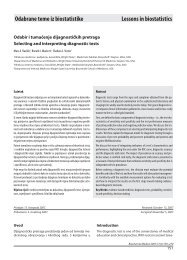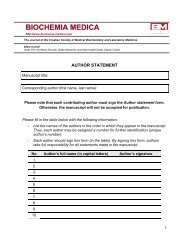Posterske teme Poster topics - Biochemia Medica
Posterske teme Poster topics - Biochemia Medica
Posterske teme Poster topics - Biochemia Medica
You also want an ePaper? Increase the reach of your titles
YUMPU automatically turns print PDFs into web optimized ePapers that Google loves.
P13-2 Endokrinologija<br />
P13-3<br />
Usporedba triju potpuno automatiziranih<br />
imunokemijskih metoda za mjerenje<br />
ukupnog HCG u serumu<br />
Kačkov S, Rogić D, Fressl G, Kralik S, Fuček M<br />
Klinički zavod za laboratorijsku dijagnostiku, KBC Zagreb, Zagreb,<br />
Hrvatska<br />
Mjerenje ukupnog HCG rabi se u ranom otkrivanju i praćenju<br />
normalne i patološke trudnoće te specifi čnih malignih<br />
bolesti. Danas na tržištu postoje brojne potpuno automatizirane<br />
imunokemijske metode za mjerenje ovoga analita.<br />
U ovoj studiji uspoređene su tri homogene imunokemijske<br />
metode s dva protutijela i to: A. metoda s elektrokemiluminiscentnom<br />
detekcijom (Roche, Elecsys 2010), B.<br />
metoda s fl uorescentnom detekcijom (BioMerieux, Vidas)<br />
te C. biotin-streptavidinska metoda s luminiscentnom detekcijom<br />
(Johnson&Johnson, Vitros). Nepreciznost (CV%)<br />
unutar i između serija bila je prihvatljiva za sve tri ispitane<br />
metode i to: A: 2,1 i 4,1; B: 4,5 i 5,7 i C: 3,2 i 6,1. Funkcionalna<br />
osjetljivost izražena kao najniža koncentracija s CV<br />
20% bila je: A 0,7 U/L, B: 2,5 U/L i C: 1,4 U/L. Poznato je<br />
da se beta-HCG u serumu, s obzirom na stadij trudnoće<br />
ili prisutnost maligne bolesti, može nalaziti u vrlo širokom<br />
rasponu mjernih koncentracija. U tom smislu, veći raspon<br />
linearnosti metode omogućuje brži i jednostavniji rad uz<br />
manji utrošak reagenasa. Linearnost ispitanih metoda bila<br />
je kako slijedi: A: 0,1-10.000 U/L, B: 2-1500 U/L i C: 0,5-1000<br />
U/L. Usporedba rezultata dobivenih svim trima ispitanim<br />
metodama (N=50) ukazala je na visoku razinu korelacije<br />
(r>0.96 za sva tri para vrijednosti), s obzirom na to da se<br />
radi o imunokemijskim metodama. Međutim, zapaženo je<br />
izrazito pozitivno odstupanje rezultata dobivenih metodom<br />
B, i to samo u području visokih vrijednosti koje prelaze<br />
linearnost te zahtijevaju prethodnu diluciju za sve tri<br />
metode. Ovaj podatak još jednom ukazuje na nemogućnost<br />
bilo kakvog praćenja bolesnika primjenom različitih<br />
imunokemijskih metoda.<br />
E-mail: sanjakackov@net.hr<br />
P13-3<br />
Comparison of three fully automated<br />
immunassays for serum total HCG<br />
determination<br />
Kačkov S, Rogić D, Fressl G, Kralik S, Fuček M<br />
Endocrinology<br />
Clinical Institute of Laboratory Diagnosis, Zagreb University Hospital<br />
Center, Zagreb, Croatia<br />
HCG determination in serum is used for detection and follow<br />
up of early pregnancy and some specifi c malignancies.<br />
There are numerous fully automated beta-HCG immunoassays<br />
available. In this study, we compared three<br />
methods, all of them homogeneous sandwich immunassays:<br />
A) electrochemiluminescence detection method<br />
(Roche, Elecsys 2010), B) fl uorescence detection method<br />
(BioMerieux, Vidas), and C) biotin-streptavidin method<br />
with luminescent signal detection (Johnson&Johnson,<br />
Vitros). Imprecision (expressed as CV%) both within- and<br />
between-run was within acceptable limits: A) 2.1 and 4.1,<br />
B) 4.5 and 5.7, and C) 3.2 and 6.1, respectively. Functional<br />
sensitivity, expressed as the lowest beta-HCG concentration<br />
that could be measured with a CV 20%, was as<br />
follows: A) 0.7 U/L, B) 2.5 U/L and C) 1.4 U/L. As it is commonly<br />
known, serum HCG concentrations, depending<br />
on the stage of pregnancy or the presence of malignant<br />
growth, can vary within several orders of magnitude.<br />
Thus, methods with higher linearity are highly preferable,<br />
since they allow for ease of operation and cost reduction.<br />
Linearities of the three methods studied were as follows:<br />
A) 0.1-10,000 U/L, B) 2-1500 U/L and C) 0.5-1000 U/L. Comparison<br />
of results obtained by all three methods (N=50)<br />
revealed a high degree of correlation, taking into account<br />
the diff erent antibodies and signal detection used (r>0.96<br />
for all three pairs of results). However, we noticed a substantial<br />
positive bias in the results obtained by method B,<br />
not throughout the concentration range but only in the<br />
results that required prior dilution. This fi nding confi rms<br />
the known fact that patient follow-up should always be<br />
performed by using the same immunochemistry method.<br />
E-mail: sanjakackov@net.hr<br />
<strong>Biochemia</strong> <strong>Medica</strong> 2006;16(Suppl 1):S1–S268<br />
S155






